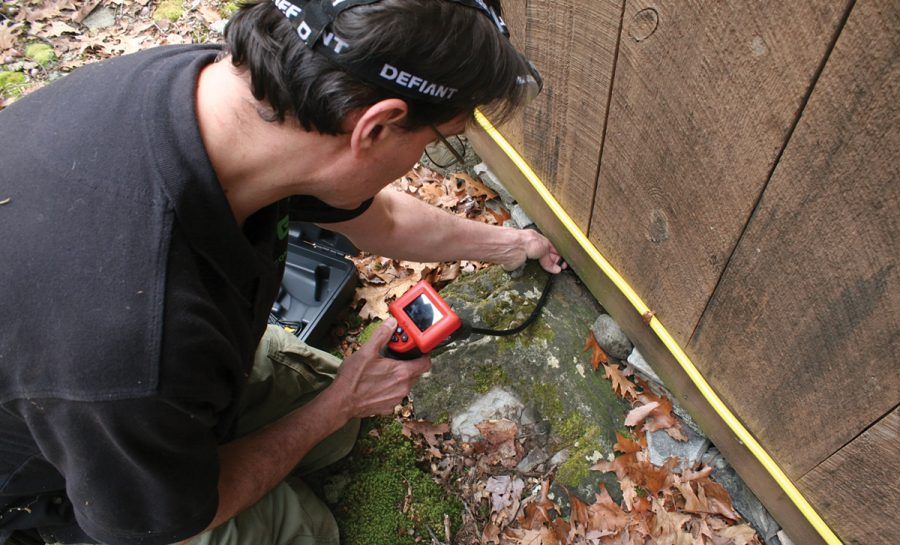The Role of Energy-Efficiency Assessments
By Melissa Esposito | Summer 2024 | Features
Every home has its story and quirks—but sometimes these quirks are indications of deeper problems. That squeaky step is less charming if it’s caused by unseen mold damage, and although a drafty room can be made cozier with space heaters in winter or fans in summer, you’re likely still paying for heating and cooling that’s leaking out through old, inefficient windows.
That’s where a home assessment by an expert trained in energy efficiency and whole-home health can come in handy. During an assessment, an auditor uses visual reviews and diagnostic tests to examine features that can impact how a house functions, and its current condition is affecting the health of its occupants.
“People often don’t realize that you can lose 30 percent of your heating and cooling through just a silver-dollar sized hole—you might not see a literal hole that large, but small areas of air leakage can add up to that equivalent,” explains Melinda McKnight, owner of Energy Conservation Services Inc. in Port Ewen, an accredited GoldStar Contractor by the Building Performance Institute. “People often get a home assessment because they’re not comfortable in their house, their electric bill is through the roof, or they want to go fossil-fuel free.”
To complete a home assessment, the auditor will start with a full external review of the building and then learn about how occupants use the interior space. For instance, if there’s a room they close off because it’s often drafty, or if a lot of time is spent in a basement office. In the main living areas, the auditor notes conditions of vent fans, kitchen appliances, window and door number and conditions, any fossil fuel-burning appliances; they’ll also examine attics, basements, and crawl spaces for concerns with venting, pipes, pests, moisture, and insulation.
“Even if existing insulation is somewhat new, we’ll still look at its condition and how it’s been installed; we often see it upside down, which can trap moisture,” McKnight says. “Unfortunately, insulation work is often seen as the last thing when making upgrades, but it’s better to look into it early on. This is also why it’s important to have an assessment done by an auditor who’s very familiar with materials and has experience in installing. Others might be able to detect that insulation would need replacement, but if they don’t understand installation, they might recommend a spray-foam in an attic—we generally don’t suggest that unless you’re turning an attic into a living space, because a specific foam needs to be used; the wrong type can cause mold or off-gasses.”
Telltale Signs
Beyond visual assessments, diagnostic tests are performed including gas leak tests, infrared thermography, blower door pressure diagnostics, and air quality tests for VOCs, particles, accumulated gasses, formaldehyde, humidity, among others.
For those considering upgrading their home for better efficiency, McKnight suggests starting with an assessment before beginning any other work, because after the audit—which should take two to three hours—you’ll receive a list of recommendations based on findings.
For instance, Energy Conservation Services was called to a Dutchess County family’s second home; the occupants were only up on weekends, but the house was always drafty. After an audit, their recommended work included adding air sealing and passive ventilation, under-floor insulation, upgraded bathroom vent fans, and weather-stripping. “The client thanked us and said that what once felt like a breezy cardboard box is now a comfortable home,” McKnight says.
There are, however, some telltale signs that homeowners can look for on their own that might indicate work is needed—unusually high utility bills and an unreliable heating system that needs frequent maintenance are often factors. “Take note of: spaces in the house that are too hot or cold, if you’re seeing condensation on windows or walls, stains on ceilings or ducts, unpleasant odors like stale air or moldy smells, and outside the building you can look for icicles in winter and even if the paint outside is constantly peeling, as this can be a cause of condensation in the wall cavity,” she says.
McKnight added that historic building upgrades are also a specialty of theirs, as they’ve developed techniques for reversible solutions. “We’ve done some work for New York State Parks, a historic barn in West Park, and our own building in Port Ewen, which is an 1850 timber frame that’s completely fossil-fuel free,” she says. “But with any type of home, we’ll typically see a reduced utility usage of an average of 20 to 40 percent. Following through with the recommendations provided can save you money, increase resale value, and make your home comfortable and healthy.”
